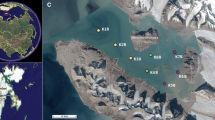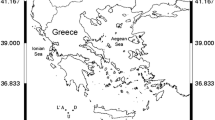Abstract
Bacteria assemblages in lake sediments play a key role in various biogeochemical processes, yet their association with interstitial pore waters has been scarcely investigated. In this study, we utilized Illumina next-generation amplicon sequencing of the 16S rRNA gene to characterize the seasonal bacterial communities in the sediments and pore waters of three contrasted temperate freshwater lakes, namely Pavin, Aydat, and Grangent (French Massif Central). Despite occupying seemingly similar habitats, bacterial communities differed substantially between sediments and pore waters at all seasons with low sharing of operational taxonomic units (OTUs, 6.7 to 20.3%) between them. Sediment-associated bacteria were more rich and diverse than pore water bacteria, indicating a high heterogeneity in the sediment microhabitat. The changes in both sediment and pore water bacterial communities were lake and season specific. The bacterial community showed distinct differences between the lakes, with larger presence of strict anaerobes such as Syntrophus, Syntrophorhabdus, and Sulfuricurvum in the pore water and sediments of Pavin responsible for carbon and sulfur cycling. In both Aydat and Grangent, the hgcI_clade dominated throughout the study period in the pore waters. The higher representation of lesser-known transient members of lake communities such as Methylotenera in the pore waters of Aydat, and Clostridium and Sulfuricurvum in the pore and sediments of Grangent, respectively, were observed during the period of temporary anoxia in summer caused by lake stratification. Our study revealed that in the investigated lakes, the prevailing environmental factors across time and space structured and influenced the adaptation of bacterial communities to specific ecological niches.





Similar content being viewed by others
References
Nealson KH (1997) Sediment bacteria: who’s there, what are they doing, and what’s new? Annu Rev Earth Planet Sci 25:403–434
Schwarz JIK, Eckert W, Conrad R (2007) Community structure of Archaea and Bacteria in a profundal lake sediment Lake Kinneret (Israel). Syst Appl Microbiol 30:239–254
Song H, Li Z, Du B, Wang G, Ding Y (2011) Bacterial communities in sediments of the shallow Lake Dongping in China. J Appl Microbiol 112:79–89
Newton RJ, Jones SE, Eiler A, McMahon KD, Bertilsson S (2011) A guide to the natural history of freshwater lake bacteria. Microbiol Mol Biol Rev 75:14–49
Steger K, Premke K, Gudasz C, Sundh I, Tranvik LJ (2011) Microbial biomass and community composition in boreal lake sediments. Limnol Oceanogr 56:725–733
Bai YH, Shi Q, Wen DH, Li ZX, Jefferson WA, Feng CP, Tang XY (2012) Bacterial communities in the sediments of Dianchi Lake, a partitioned eutrophic waterbody in China. PLoS One 7:e37796
Chen N, Yang JS, Qu JH, Li HF, Liu WJ, Li BZ, Wang ET, Yuan HL (2015) Sediment prokaryote communities in different sites of eutrophic Lake Taihu and their interactions with environmental factors. World J Microbiol Biotechnol 31:883–896
Schettler G, Schwab MJ, Stebich M (2007) A 700-year record of climate change based on geochemical and palynological data from varved sediments (Lac Pavin, France). Chem Geol 240:11–35
EPA (1991) Sediment toxicity identification: phase I (characterization), phase II (identification) and phase III (confirmation) modifications of effluent procedures. National Effluent Toxicity Assessment Center. Technical Report, EPA/600/6-91/007. United States Environmental Protection Agency, Washington DC
Rieck A, Herlemann DPR, Jürgens K, Grossart HP (2015) Particle-associated differ from free-living bacteria in the surface waters of the Baltic Sea. Front Microbiol 6:1297
Lønborg C, Søndergaard M (2009) Microbial availability and degradation of dissolved organic carbon and nitrogen in two coastal areas. Estuar Coast Shelf Sci 81:513–520
Mahaffey C, Benitez-Nelson CR, Bidigare RR, Rii Y, Karl DM (2008) Nitrogen dynamics within a wind-driven eddy. Deep-Sea Res Pt II 55:1398–1411
Liu Z, Lozupone C, Hamady M, Bushman FD, Knight R (2007) Short pyrosequencing reads suffice for accurate microbial community analysis. Nucleic Acids Res 35:e120
Pradeep Ram AS, Chaibi-Slouma S, Keshri J, Colombet J, Sime-Ngando T (2016) Functional responses of bacterioplankton diversity and metabolism to experimental bottom-up and top-down forcings. Microb Ecol 72:347–358
Schloss PD, Westcott SL, Ryabin T, Hall JR, Hartmann M, Hollister EB, et al. (2009) Introducing mothur: open-source, platform-independent, community-supported software for describing and comparing microbial communities. Appl Environ Microbiol 75:7537–7541
Kozich JJ, Westcott SL, Baxter NT, Highlander SK, Schloss PD (2013) Development of a dual-index sequencing strategy and curation pipeline for analyzing amplicon sequence data on the MiSeq Illumina sequencing platform. Appl Environ Microbiol 79:5112–5120
Pruesse E, Quast C, Knittel K, Fuchs BM, Ludwig W, Peplies J, Glöckner FO (2007) SILVA, a comprehensive online resource for quality checked and aligned ribosomal RNA sequence data compatible with ARB. Nucleic Acids Res 35:7188–7196
Yue JC, Clayton MK (2005) A similarity measure based on species proportions. Commun Stat–Theor M 34:2123–2131
Danovaro R, Dell’Anno A, Trucco A, Vannucci S (2001) Determination of virus abundance in marine sediments. Appl Environ Microbiol 67:1384–1387
Montanié H, De Crignis MG, Lavaud J (2015) Viral impact on prokaryotic and microalgal activities in the microphytobenthic biofilm of an intertidal mudflat (French Atlantic Coast). Front Microbiol 6:1214
Duhamel S, Jacquet S (2006) Flow cytometric analysis of bacteria- and virus-like particles in the lake sediments. J Microbiol Methods 64:316–332
Brussaard C, Payet JP, Winter C, Weinbauer MG (2010) Quantification of aquatic viruses by flow cytometry. In: Wilhelm SW, Weinbauer MG, Suttle C (eds) Manual of aquatic viral ecology. American Society of Limnology and Oceanography, Texas, pp. 102–109
Bouvier T, del Giorgio PA, Gasol JM (2007) A comparative study of the cytometric characteristics of high and low nucleic-acid bacterioplankton cells from different aquatic ecosystems. Environ Microbiol 9:2050–2066
Lozupone C, Hamady M, Knight R (2006) UniFrac—an online tool for comparing microbial community diversity in a phylogenetic context. BMC Bioinformatics 7:371
Lehours A-C, Evans P, Bardot C, Joblin K, Fonty G (2007) Phylogenetic diversity of archaea and bacteria in the anoxic zone of a meromictic lake (Lake Pavin, France). Appl Environ Microbiol 73:2016–2019
Lehours A-C, Bardot C, Pelisson P-F, Guedon A, Pesce S, Demeure G, Sargos D, Fonty G (2009) Successional changes in bacterial community assemblages following anoxia in the hypolimnion of a eutrophic lake. Aquat Microb Ecol 54:71–82
Wang Y, Sheng HF, He Y, Wu JY, Jiang YX, Tam NFY, Zhou HW (2012) Comparison of the levels of bacterial diversity in freshwater, intertidal wetland, and marine sediments by using millions of Illumina tags. Appl Environ Microbiol 78:8264–8271
Zhang JX, Yang YY, Zhao L, Li YZ, Xie SG, Liu Y (2015) Distribution of sediment bacterial and archaeal communities in plateau freshwater lakes. Appl Microbiol Biotechnol 99:3291–3302
Dai Y, Yang Y, Wu Z, Feng Q, Xie S, Liu Y (2016) Spatiotemporal variation of planktonic and sediment bacterial assemblages in two plateau freshwater lakes at different trophic status. Appl Microbiol Biotechnol 100:4161–4175
Crump BC, Amaral-Zettler LA, Kling GW (2012) Microbial diversity in arctic freshwaters is structured by inoculation of microbes from soils. ISME J 6:1629–1639
Ortega-Retuerta E, Joux F, Jeffrey WH, Ghiglione JF (2013) Spatial variability of particle-attached and freeliving bacterial diversity in surface waters from the Mackenzie River to the Beaufort Sea (Canadian Arctic). Biogeosciences 10:2747–2759
Bižic-Ionescu M, Zeder M, Ionescu D, Orlić S, Fuchs BM, Grossart H-P, Amann R (2015) Comparison of bacterial communities on limnic versus coastal marine particles reveals profound differences in colonization. Environ Microbiol 17:3500–3514
Yakimov MM, Giuliano L, Cappello S, Denaro R, Golyshin PN (2007) Microbial community of a hydrothermal mud vent underneath the deep-sea anoxic brine lake Urania (eastern Mediterranean). Orig Life Evol Biosph 37:177–188
Hamilton TL, Bovee RJ, Sattin SR, et al. (2016) Carbon and sulphur cycling below the chemocline in a meromictic lake and the identification of a novel taxonomic lineage in the FCB superphylum Candidatus aegiribacteria. Front Microbiol 7:598
Jin L, Lee CS, Ahn CY, et al. (2017) Abundant iron and sulphur oxidizers in the stratified sediment of a eutrophic freshwater reservoir with annual cyanobacterial blooms. Sci Rep 7:43814
Glöckner FO, Zaichikov E, Belkova N, et al. (2000) Comparative 16S rRNA analysis of lake bacterioplankton reveals globally distributed phylogenetic clusters including an abundant group of actinobacteria. Appl Environ Microbiol 66:5053–5065
Comeau AM, Harding T, Galand PE, et al. (2012) Vertical distribution of microbial communities in a perennially stratified Arctic lake with saline, anoxic bottom waters. Sci Rep 2:604
Wang NF, Zhang T, Yang X, Wang S, Yu Y, Dong LL, Guo YD, Ma YX, Zang JY (2016) Diversity and composition of bacterial community in soils and lake sediments from an Arctic lake area. Front Microbiol 7:1170
Sun MY, Dafforn KA, Johnston EL, Brown MV (2013) Core sediment bacteria drive community response to anthropogenic contamination over multiple environmental gradients. Environ Microbiol 15:2517–2531
Crump BC, Amaral-Zettler LA, Kling GW (2012) Microbial diversity in arctic freshwaters is structured by inoculation of microbes from soils. ISME J 6:1629–1639
Febria CM, Beddoes P, Fulthorpe RR, Williams DD (2012) Bacterial community dynamics in the hyporheic zone of an intermittent stream. ISME J 6:1078–1088
Liu Y, Yang SF, Li Y, Yu H, Qin L, Tay JH (2004) The influence of cell and substratum surface hydrophobicities on microbial attachment. J Biotechnol 110:251–256
Liao C, Liang X, Soupir ML, Jarboe LR (2015) Cellular, particle and environmental parameters influencing attachment in surface waters: a review. J Appl Microbiol 119:315–330
Zhao D, Xu H, Zeng J, Cao X, Huang R, Shen F, Yu Z (2017) Community composition and assembly processes of the free-living and particle-attached bacteria in Taihu Lake. FEMS Microbiol Ecol 93:fix62
Kou W, Zhang J, Lu X, Ma Y, Mou X, Wu L (2016) Identification of bacterial communities in sediments of Poyang Lake, the largest freshwater lake in China. SpringerPlus 5:401
Cottrell MT, Kirchman DL (2003) Natural assemblages of marine Proteobacteria and members of the Cytophaga-Flavobacter cluster consuming low- and high-molecular-weight dissolved organic matter. Appl Environ Microbiol 66:1692–1697
Acknowledgements
JK was supported by a postdoctoral fellowship from the Université Clermont Auvergne (formerly Université Blaise Pascal), Clermont Ferrand (France). We thank J. Colombet and F. Perriere for their technical assistance in flow cytometry and nutrient analysis respectively. We appreciate the two reviewers for their time, effort, and valuable contributions to this manuscript.
Author information
Authors and Affiliations
Corresponding author
Ethics declarations
Conflict of Interest
The authors declare that they have no competing interests.
Electronic supplementary materials
ESM 1
(DOCX 959 kb)
Rights and permissions
About this article
Cite this article
Keshri, J., Pradeep Ram, A.S. & Sime-Ngando, T. Distinctive Patterns in the Taxonomical Resolution of Bacterioplankton in the Sediment and Pore Waters of Contrasted Freshwater Lakes. Microb Ecol 75, 662–673 (2018). https://doi.org/10.1007/s00248-017-1074-z
Received:
Accepted:
Published:
Issue Date:
DOI: https://doi.org/10.1007/s00248-017-1074-z




